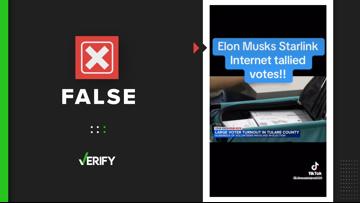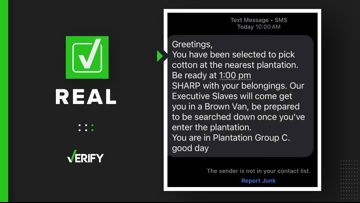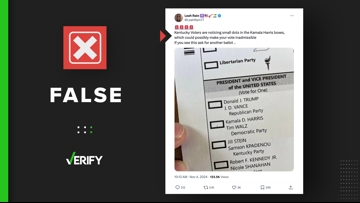Human trafficking refers to a crime where traffickers profit at the expense of other people by forcing them to engage in commercial sex or perform other types of labor.
Posts shared across social media platforms over the years have warned people of alleged tactics that sex traffickers are using to target their victims.
Some of the posts warn that traffickers are marking vehicles with codes or putting zip ties on car door handles to identify potential victims. One article claims the zip ties method “signals other traffickers to let them know that you may be a potential target.”
Other posts claim sex traffickers are using abandoned car seats to lure potential victims before abducting them. Another viral online warning claims traffickers are placing tissues or napkins laced with toxins on car door handles or gas pumps to incapacitate potential victims.
Several VERIFY readers have asked us whether there’s any truth to these posts.
We spoke with law enforcement professionals and several experts who work with human trafficking victims to bring you the facts.
THE QUESTION
Is there evidence sex traffickers are using tactics shared in viral social media warnings to target their victims?
THE SOURCES
- Polaris Project, nonprofit organization that operates the National Human Trafficking Hotline
- Guardian Group, nonprofit organization that helps identify and locate women and children that are victims of sex trafficking
- Steve Vienneau, supervisory special agent with FBI Seattle
- Stefanie Hanley, victim specialist with FBI Seattle
- Shea Rhodes, co-founder and director of the Institute to Address Commercial Sexual Exploitation (CSE Institute) at Villanova University’s School of Law
- Mellissa Withers, Ph.D., an associate professor of clinical preventive medicine at the University of Southern California who researches human trafficking
- Wilkesboro Police Department in North Carolina
THE ANSWER
No, there is no evidence sex traffickers are using tactics shared in viral social media warnings to target their victims.
WHAT WE FOUND
All of our sources told us there is no evidence sex traffickers are using the tactics outlined in these social media posts to identify, lure or abduct their victims.
“There’s no such thing that I’ve ever heard of in almost 20 years of working trafficking,” Steve Vienneau, a supervisory special agent with FBI Seattle who investigates sexual exploitation and human trafficking crimes, said.
“I have yet to work with a victim in seven years where anything you just said was part of a federal case or even a King County case,” Stefanie Hanley, a victim specialist with FBI Seattle, told VERIFY.
Polaris Project, a nonprofit, nongovernmental organization that runs the National Human Trafficking Hotline, has looked into the online rumors about zip ties and marked car windows.
“Rumors about the use of zip ties or marking of vehicles by traffickers have been proven to be false,” Polaris says on its website. “We examined data from the U.S. National Human Trafficking Hotline from January 2015 to December 2021 and found that there have been zero cases of zip ties being used as lures or markers that alert a potential trafficker of a vulnerable person.”
The Guardian Group, a nonprofit organization that helps identify and locate women and children who are victims of sex trafficking, also says “this specific method of marking vehicles” with zip ties or other codes “has been proven false.”
There is “no evidence” to support claims of sex traffickers using abandoned car seats to lure victims, either, Polaris says. The nonprofit looked at data from the same time period of 2015 to 2021 and didn’t find any such cases.
A local law enforcement agency also debunked the same claim about car seats.
In 2021, a Facebook post claimed sex traffickers were using the abandoned car seats tactic in the parking lot of a Walmart in Wilkesboro, North Carolina. But the town’s police department said on Facebook that the incident had nothing to do with sex trafficking or any crime at all.
“The Wilkesboro Police Department has investigated this incident and discovered the circumstances of how the seat was left in the parking lot,” the post reads. “Two customers walked out of Wal-Mart after purchasing a new child car seat. An older seat was removed from the ground and a new child seat was installed. The customers then left the parking lot leaving the old child seat behind on the ground.”
A spokesperson for Polaris also told VERIFY the National Human Trafficking Hotline “has not received any reports referencing the use of napkins as a means of recruiting victims.”
Other non-law enforcement experts agree that the online rumors are baseless.
The warnings shared on social media have not been linked to actual missing persons or abduction cases, Shea Rhodes, co-founder and director of the Institute to Address Commercial Sexual Exploitation (CSE Institute) at Villanova University’s School of Law, said.
“I think that if these sort of warning signs had any credibility to them, we would be hearing from the leaders with the Department of Justice,” Rhodes said. “...You can’t trace [the warnings] back to something based in fact.”
Mellissa Withers, an associate professor of clinical preventive medicine at the University of Southern California who researches human trafficking, agrees.
“I’ve heard these urban legends that have been going around for some time about…zip ties and napkins, and things being put into people’s car windshields or in their door handles,” she said. “Within my own experience, I’ve never actually heard of anything like that happening to a victim of human trafficking.”
Why these rumors continue to spread online
One reason behind the continued spread of these online rumors is a widely shared belief that trafficking often involves kidnapping or other physical force by strangers.
But Polaris calls this “the most pervasive myth about human trafficking.” Abduction is “not a common method of recruitment for traffickers,” a spokesperson for the nonprofit added.
“I think this really reflects in our society our desire to portray sex trafficking using a more Hollywood version of what sex trafficking or human trafficking looks like, where we think of the movie version of victims being kidnapped off the streets,” Withers said.
“Maybe we don’t want to face how [trafficking] actually happens, which is generally a much more methodical, insidious kind of practice of grooming and manipulation – generally over a very long period of time,” she added.
Traffickers typically “use emotional manipulation and control to recruit victims and keep them trapped long-term,” allowing them to “avoid unwanted attention from media, law enforcement or the community,” the Polaris spokesperson said.
In many cases, victims know the person who is trafficking them, Rhodes and Polaris said. The trafficker could be a friend, romantic partner, parent or another other family member, according to Polaris.
How pervasive social media rumors can harm victims of trafficking
Though some people who share these unfounded rumors online believe they are providing helpful reminders about staying vigilant, Polaris says they can do “serious harm to actual trafficking survivors.”
“If the narrative on social platforms is this sensationalized, inaccurate story and that becomes the dominant narrative about how trafficking happens, people who are experiencing trafficking might not recognize their own experiences in these types of stories,” Polaris wrote in a 2021 Facebook post.
If survivors don’t see themselves in these online narratives, they may be less likely to come forward or seek help, Rhodes said.
Withers encourages people to contact authorities if they suspect a person may be a trafficking victim.
“I always tell people you don’t have to be sure. If you have a really gut instinct that something might be wrong, it’s better to just call it in,” she said.
People who believe they may have information about a trafficking situation can call the National Human Trafficking Hotline at 1-888-373-7888. The hotline is also available via text at 233733 (BEFREE) and allows people to submit anonymous tips on its website.
You can also report suspected human trafficking activity directly to federal law enforcement agencies online or via phone.












